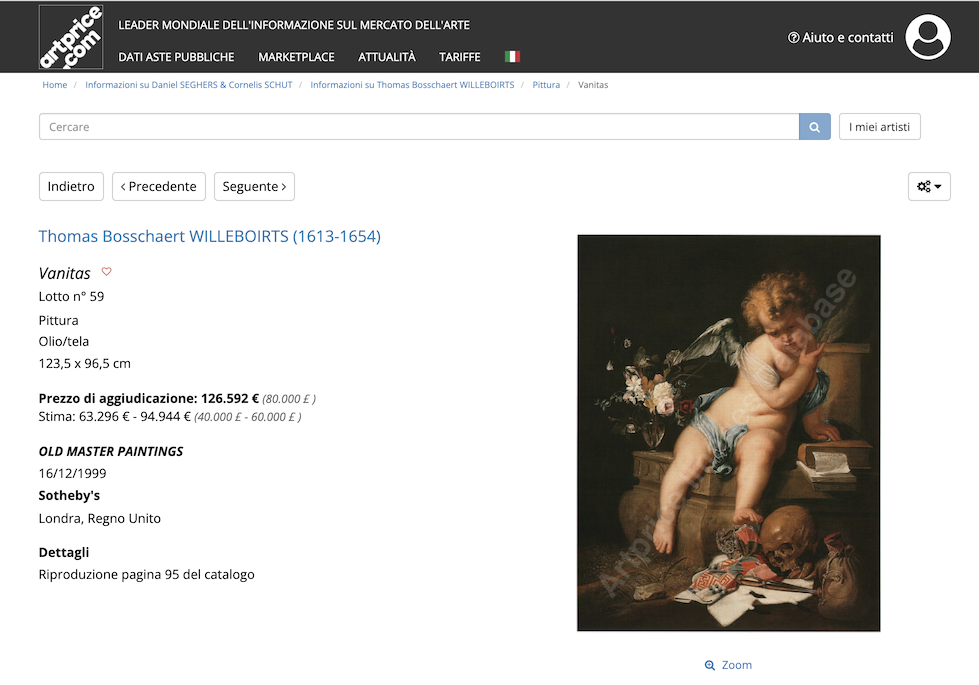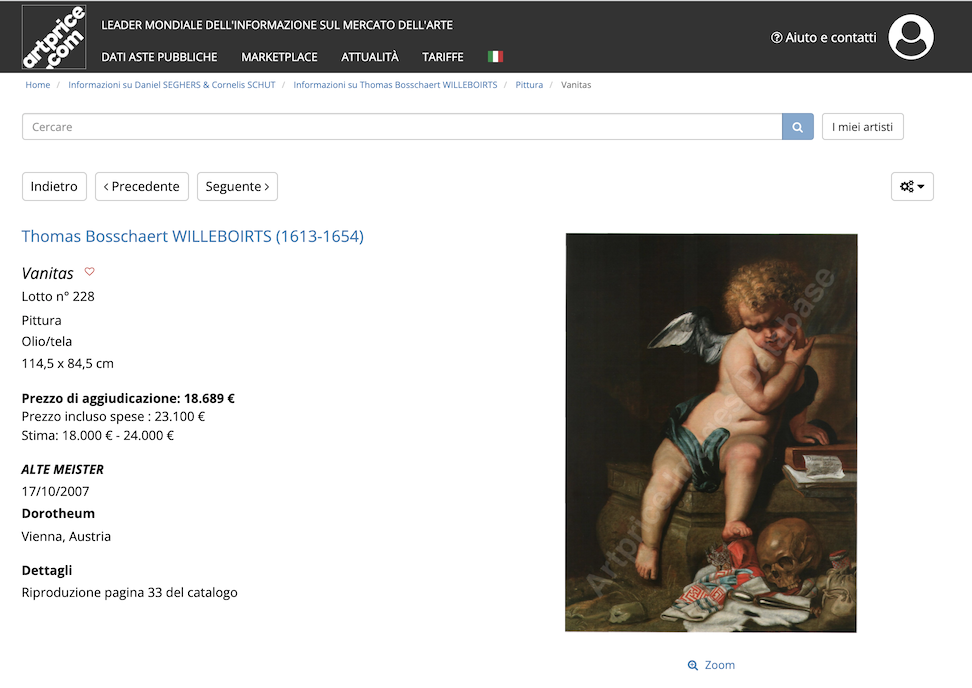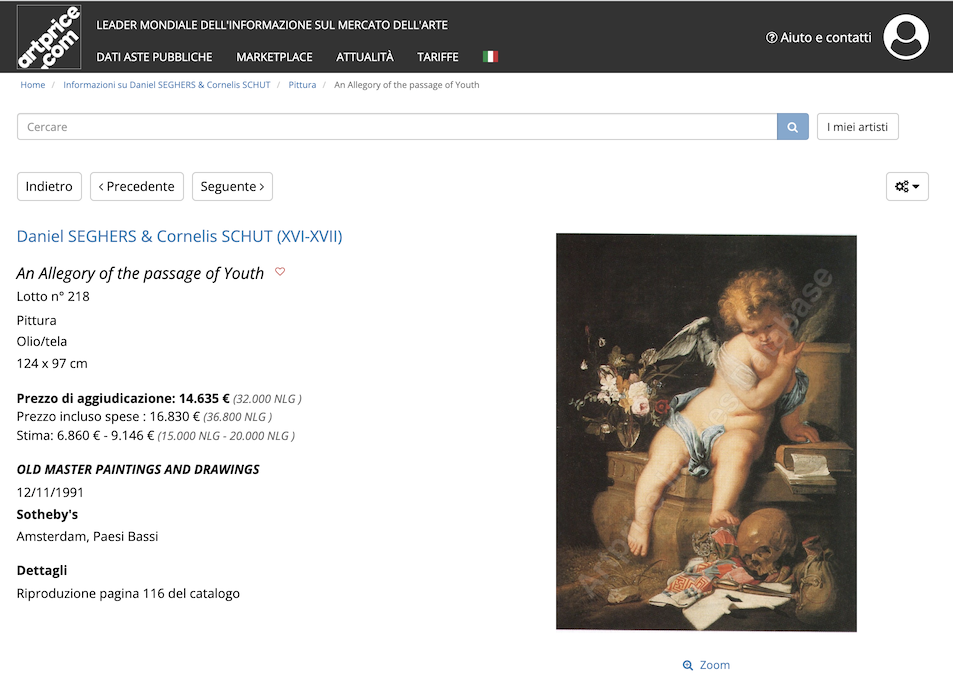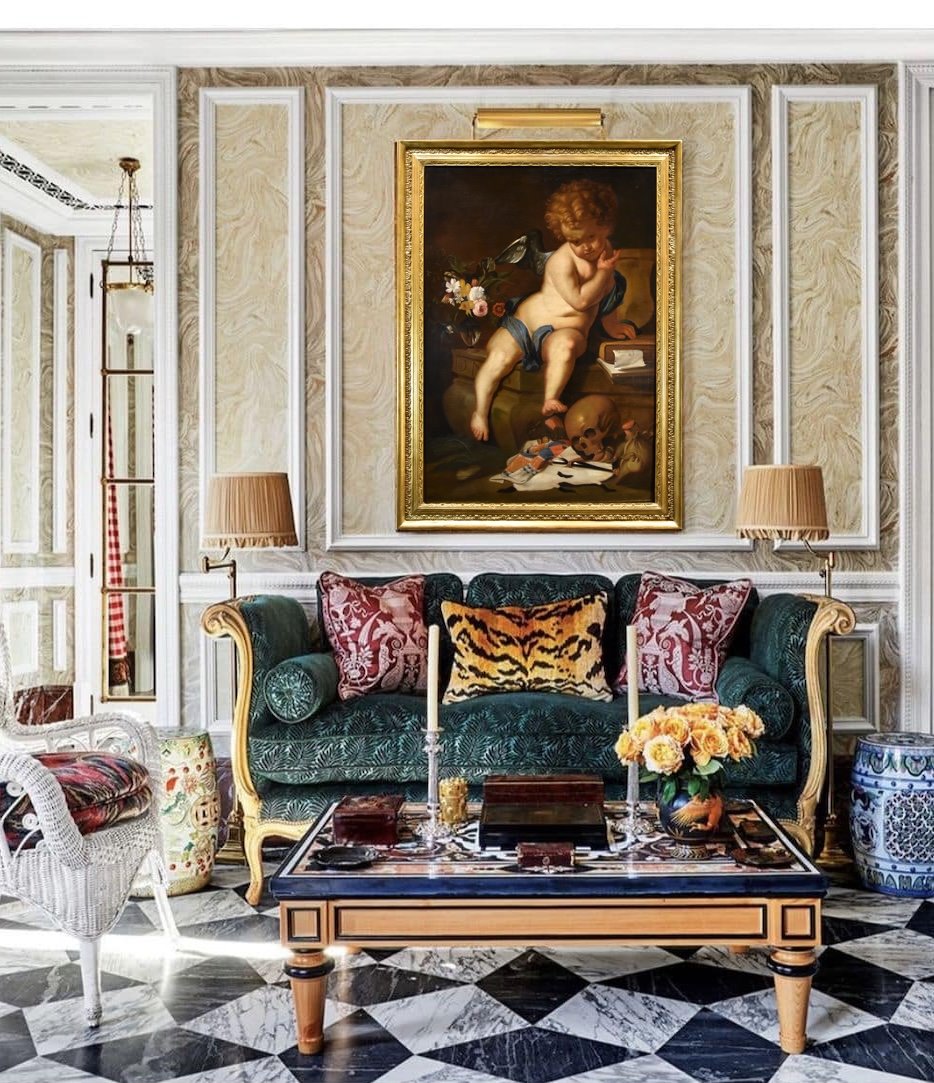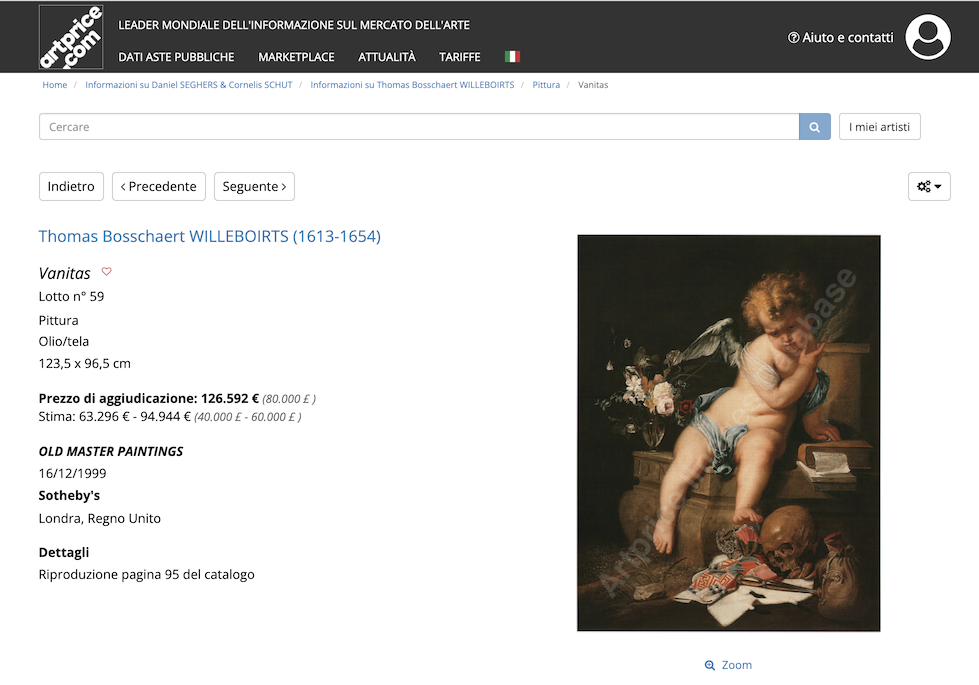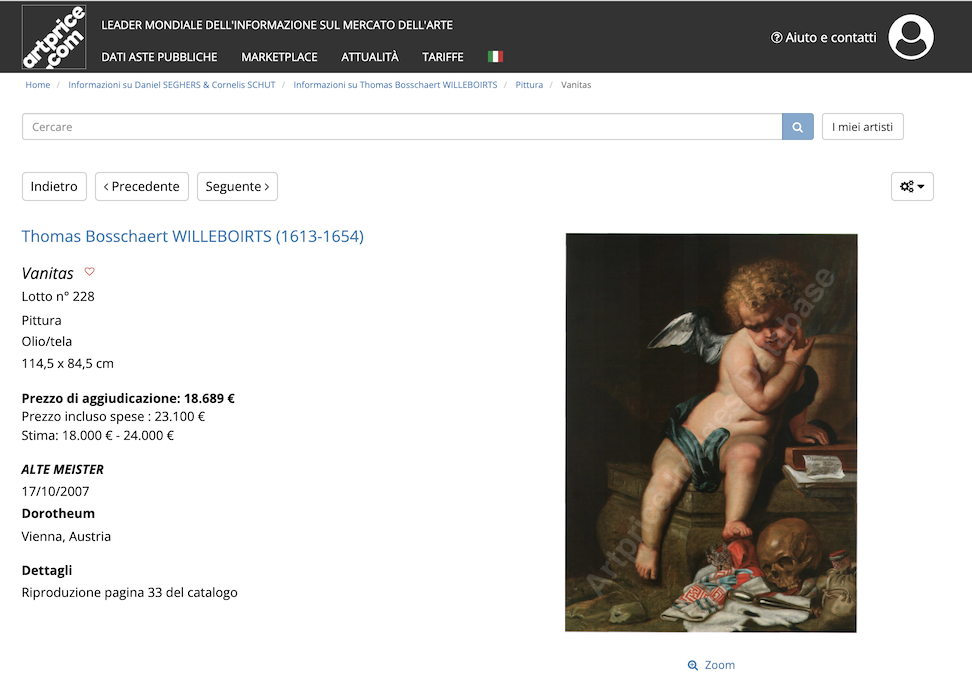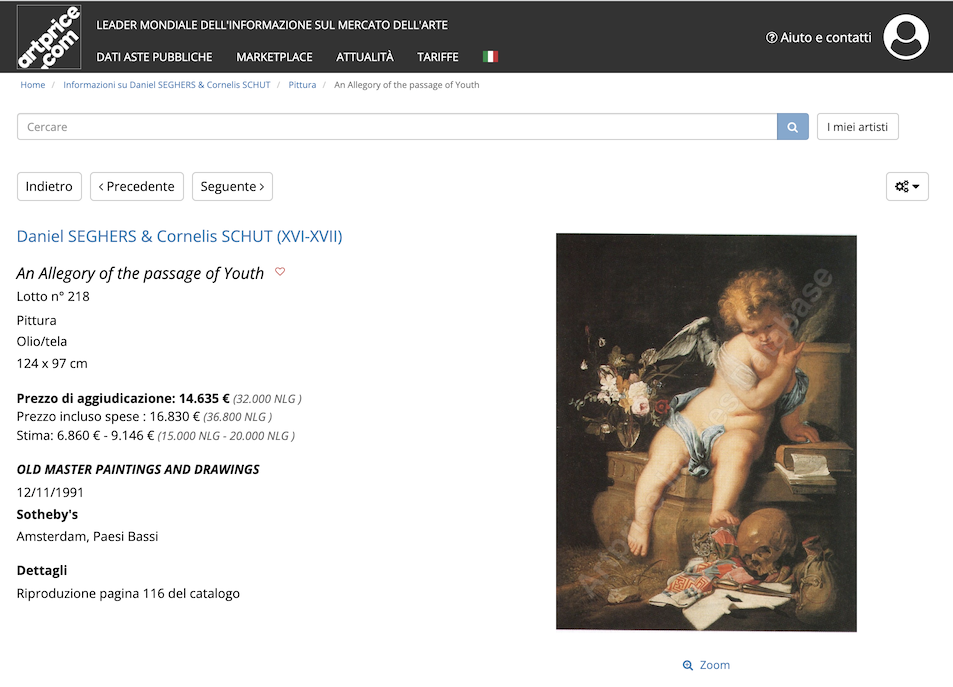Erasmus Quellinus II (Anversa 1607 - 1672)
Vanitas come allegoria della giovinezza
Erasmus Quellinus II
(Antwerp 1607 - 1672)
(Antwerp 1607 - 1672)
Vanitas (as Allegory of the Vanity of Life or Youth)
Oil on canvas
121 x 84 cm.
Framed 135 x 98 cm.
Framed 135 x 98 cm.
The work is accompanied by a critical study written by Prof. Emilio Negro
The theme of the painting we are offering is a unique and rare ‘Vanitas’, a subject with strong moral significance which, in painting, refers to a composition with symbolic elements alluding to the transience of life, and therefore intended to prompt the viewer to meditate on the transience of human destiny and the fragility of worldly pleasures.
Such subjects, which were particularly popular in the Flemish school, are works of great charm, interesting to study and often difficult to decipher. The protagonist of our canvas is a capricious cherub sitting on a sarcophagus, a sort of anthropomorphic Carpe Diem (seize the fleeting moment) in pictorial form, inviting us to meditate on the fleeting nature of life and enjoy the moments of happiness it offers, without worrying about the vicissitudes of fortune, symbolised by the cherub's foot trampling on gold coins, precious fabric, a sceptre, an ermine stole, a skull, a hunting horn and books.
Next to him is a still life of colourful flowers gathered in a crystal vase, whose presence takes on a clear allegorical meaning, as they are a metaphor for the transience of youthful beauty, which, like fresh flowers, is destined to wither.
Particularly noteworthy is the bare stone tomb on which the cherub sits, above which stands the inscription ‘D. M. S.,' engraved in beautiful Roman capital letters, which can be interpreted as the Latin phrase “Diis Manibus Sacrum”, meaning “Sacred to the Manes”, corresponding to the invocation carved on the tombstones of late paganism and the early Christian period, addressed to the spirits of deified ancestors.
Another very interesting detail is the white sheet protruding from the pages of the voluminous closed psalter (the biblical text containing the collection of Psalms) on which the Latin phrase is written in beautiful 17th-century cursive calligraphy: ‘(Quia] Defecerunt sicut fumus dies/ mei Psal J.97' (translation: “[Because] my days have vanished like smoke” (Psalter, Psalm 1:97), equivalent to another exhortation to reflect on the brevity of existence.
With regard to the pictorial origin of the composition in question, it should first be noted that it is an interesting replica, with some modifications, of a work executed by Erasmus Quellinus the Younger (the figure of the cherub) and Daniel Seghers (the still life).
A version of the same composition is also known, entitled ‘Allegory of the Passage of Youth’, which passed through Sotheby's in Amsterdam as Cornelis Schut and Daniël Seghers (12.12. 1991, Old Master Paintings and Drawings, lot 218, price €16,630, then sold in London as Thomas Willeboirts Bosschaert (Sotheby's 16.12.1999, lot 59, hammer price: €126,592 / £80,000).
Qui il link del dipinto: https://research.rkd.nl/en/detail/https%3A%2F%2Fdata.rkd.nl%2Fimages%2F52665?c=q%3D%26filters%255B0%....
And then there is the Vanity attributed to Thomas Willeboirts Bosschaert, which was sold in Vienna by Dorotheum (17/10/2007, estimated price: €18,000-24,000, link:
As regards the painting in question, we can attribute its creation to a skilled Flemish artist of the Grand Siècle, attentive to detail and faithful to the teachings learned through the study of compositions by the best 17th-century masters: in fact, clear post-Caravaggio and post-Rubens accents stand out in our canvas, typical of the pupils of Wallerant Vaillant; these are distinctive stylistic features that can be seen in the effective contrasts of light and in the fluid pictorial mixture and balanced colours.
These reasons allow us to link this Vanitas to the modus operandi of the aforementioned Erasmus Quellinus the Younger (Antwerp, 1607-1678), one of Rubens' closest collaborators in the 1630s, assisted here by a talented collaborator trained in his active workshop.
Descended from a renowned family of artists (his father was the painter Erasmus Quellinus the Elder), Erasmus Quellinus II worked mainly in Flanders, where his activity is evidenced by numerous compositions similar to ours, attributed to him and preserved in the most important public and private collections. He was also the head of a successful workshop where numerous pupils were trained, including his children and grandchildren. It is true that in the canvas in question, which was probably intended to adorn the walls of a noble residence belonging to a collector, man of letters or humanist, there is a careful painting, especially in the insistent search for detail, in warm colours, which are specific qualities of the best works by Erasmus.
ADDITIONAL INFORMATION:
The painting is sold complete with a pleasant gilded frame and comes with a certificate of authenticity and a descriptive iconographic card.
We take care of and organise the transport of purchased works, both in Italy and abroad, through professional and insured carriers.
If you would like to see this or other works in person, we would be delighted to welcome you to our new gallery in Riva del Garda, at Viale Giuseppe Canella 18. We look forward to seeing you!
Please contact us for any information or to arrange a visit, we will be happy to assist you.
In the event of purchase by non-Italian customers, an export permit will be required, which takes approximately 10-20 days to obtain. Our gallery will take care of the entire process until the permit is obtained. All costs associated with this operation are included.
Follow us on:
